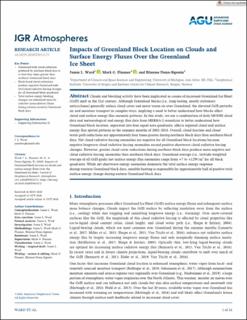Impacts of Greenland Block Location on Clouds and Surface Energy Fluxes over the Greenland Ice Sheet
Journal article, Peer reviewed
Published version

Åpne
Permanent lenke
https://hdl.handle.net/11250/2766229Utgivelsesdato
2020Metadata
Vis full innførselSamlinger
- Geophysical Institute [1187]
- Registrations from Cristin [9489]
Originalversjon
Journal of Geophysical Research (JGR): Atmospheres. 2020, 125(22), e2020JD033172 https://doi.org/10.1029/2020JD033172Sammendrag
Clouds and blocking activity have been implicated as causes of increased Greenland Ice Sheet (GrIS) melt in the 21st century. Although Greenland blocks (i.e., long-lasting, mostly stationary anticyclones) generally reduce cloud cover and move warm air over Greenland, the elevated GrIS perturbs air and moisture transport in complex ways, implying a need to better understand how blocks affect cloud and surface energy flux anomaly patterns. In this study, we use a combination of daily MODIS cloud data and meteorological and energy flux data from MERRA-2 reanalysis to better understand how Greenland block location, separated into four equal-area quadrants, affects regional cloud and surface energy flux spatial patterns in the summer months of 2002–2018. Overall, cloud fraction and cloud water path reductions are approximately four times greater during northern block days than southern block days. Net cloud radiative forcing anomalies are negative for all Greenland block locations because negative longwave cloud radiative forcing anomalies exceed positive shortwave cloud radiative forcing changes. However, greater cloud cover reductions during northern block days produce more negative net cloud radiative forcing anomalies than southern block days. Greenland-average (i.e., latitude-weighted average of all GrIS grids) net surface energy flux anomalies range from +7 to +12W/m2 for all block quadrants. While net shortwave energy anomalies dominate the total surface energy response during western Greenland block days, sensible heating is responsible for approximately half of positive total surface energy change during eastern Greenland block days.